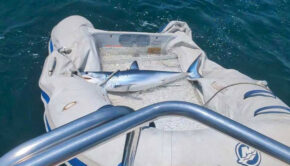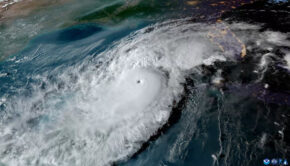Destruction begins with force of Hurricane Irma
Published on September 6th, 2017
(September 6, 2017) – Hurricane Irma, one of the strongest storms ever recorded in the Atlantic, hit the eastern Caribbean today with winds of up to 185 miles an hour. Damage in Antigua was not as severe as expected but its sister island Barbuda had been 90% destroyed. The Category 5 storm went on to wreak havoc in the Virgin Islands with the path of the extremely dangerous core heading just north of Puerto Rico tonight, pass near or just north of the coast of Hispaniola tomorrow, and be near the Turks and Caicos and southeastern Bahamas by tomorrow evening.
Here’s the update (500 PM AST Wed Sep 06 2017) from the National Hurricane Center:
EYE OF CATEGORY 5 HURRICANE IRMA MOVING AWAY FROM THE NORTHERNMOST VIRGIN ISLANDS…TROPICAL STORM AND HURRICANE CONDITIONS SPREADING OVER PORTIONS OF PUERTO RICO…
SUMMARY OF 500 PM AST…2100 UTC…INFORMATION
———————————————-
LOCATION…18.8N 65.4W
ABOUT 40 MI…60 KM NW OF ST. THOMAS
ABOUT 55 MI…85 KM ENE OF SAN JUAN PUERTO RICO
MAXIMUM SUSTAINED WINDS…185 MPH…295 KM/H
PRESENT MOVEMENT…WNW OR 285 DEGREES AT 16 MPH…26 KM/H
MINIMUM CENTRAL PRESSURE…914 MB…26.99 INCHES
WATCHES AND WARNINGS
——————–
CHANGES WITH THIS ADVISORY:
The government of the Bahamas has issued a Hurricane Warning for the central Bahamas, including Cat Island, the Exumas, Long Island, Rum Cay, and San Salvador. A Hurricane Watch has been issued for the northwestern Bahamas, including the Abacos, Andros Island, Berry Islands, Bimini, Eleuthera, Grand Bahama Island, and New Providence.
The government of Cuba has issued a Tropical Storm Warning for the Cuban provinces of Guantanamo, Holguin, and Las Tunas.
The government of France has discontinued the Hurricane Warning for Saint Martin and Saint Barthelemy.
SUMMARY OF WATCHES AND WARNINGS IN EFFECT:
A Hurricane Warning is in effect for…
* British Virgin Islands
* U.S. Virgin Islands
* Puerto Rico, Vieques, and Culebra
* Dominican Republic from Cabo Engano to the northern border with Haiti
* Haiti from the northern border with the Dominican Republic to Le Mole St. Nicholas
* Southeastern Bahamas and the Turks and Caicos Islands
* Central Bahamas
A Hurricane Watch is in effect for…
* Cuba from Matanzas province eastward to Guantanamo province
* Northwestern Bahamas
A Tropical Storm Warning is in effect for…
* Dominican Republic from south of Cabo Engano westward to the southern border with Haiti
* Haiti from south of Le Mole St. Nicholas to Port-Au-Prince
* Cuba provinces of Guantanamo, Holguin, and Las Tunas
A Hurricane Warning means that hurricane conditions are expected somewhere within the warning area. Preparations to protect life and property should be rushed to completion.
A Hurricane Watch means that hurricane conditions are possible within the watch area. A watch is typically issued 48 hours before the anticipated first occurrence of tropical-storm-force winds, conditions that make outside preparations difficult or dangerous.
A Tropical Storm Warning means that tropical storm conditions are expected somewhere within the warning area.
Interests elsewhere in the Dominican Republic and Haiti, as well as Cuba, the northwestern Bahamas, and Florida should monitor the progress of Irma.
For storm information specific to your area in the United States, including possible inland watches and warnings, please monitor products issued by your local National Weather Service forecast office. For storm information specific to your area outside the United States, please monitor products issued by your national meteorological service.
DISCUSSION AND 48-HOUR OUTLOOK
——————————
At 500 PM AST (2100 UTC), the eye of Hurricane Irma was located near latitude 18.8 North, longitude 65.4 West. Irma is moving toward the west-northwest near 16 mph (26 km/h), and this general motion is expected to continue for the next couple of days. On the forecast track, the extremely dangerous core of Irma will pass just north of Puerto Rico tonight, pass near or just north of the coast of Hispaniola Thursday, and be near the Turks and Caicos and southeastern Bahamas by Thursday evening.
Maximum sustained winds are near 185 mph (295 km/h) with higher gusts. Irma is a category 5 hurricane on the Saffir-Simpson Hurricane Wind Scale. Some fluctuations in intensity are likely during the next day or two, but Irma is forecast to remain a powerful category 4 or 5 hurricane during the next couple of days.
Hurricane-force winds extend outward up to 50 miles (85 km) from the center and tropical-storm-force winds extend outward up to 185 miles (295 km). A wind gust to 62 mph (100 km/h) has been recently reported at San Juan, Puerto Rico.
The estimated minimum central pressure based on Air Force reconnaissance aircraft data is 914 mb (26.99 inches).
HAZARDS AFFECTING LAND
———————-
STORM SURGE: The combination of a life-threatening storm surge and large breaking waves will raise water levels ABOVE NORMAL TIDE LEVELS by the following amounts within the hurricane warning area near and to the north of the center of Irma. Near the coast, the surge will be accompanied by large and destructive waves.
Turks and Caicos Islands…15 to 20 ft
Southeastern and central Bahamas…15 to 20 ft
Northern coast of the Dominican Republic…3 to 5 ft
Northern coast of Haiti and the Gulf of Gonave…1 to 3 ft
Northern coast of Cuba in the warning area…5 to 10 ft
Water levels in the Leeward Islands will gradually subside tonight.
The combination of a life-threatening storm surge and the tide will cause normally dry areas near the coast to be flooded by rising waters moving inland from the shoreline. The water is expected to reach the following HEIGHTS ABOVE GROUND if the peak surge occurs at the time of high tide…
British and U.S. Virgin Islands except St. Croix…7 to 11 ft
Northern coast of Puerto Rico…4 to 6 ft
Southern coast of Puerto Rico and St. Croix…2 to 4 ft
The deepest water will occur along the immediate coast in areas of onshore winds, where the surge will be accompanied by large and destructive waves. Surge-related flooding depends on the relative timing of the surge and the tidal cycle, and can vary greatly over short distances. For information specific to your area, please see products issued by your local National Weather Service forecast office.
WIND: Tropical Storm and Hurricane conditions are occurring over the British and U.S. Virgin Islands and will spread westward over portions of Puerto Rico tonight. Hurricane conditions are expected to begin within the hurricane warning area in the Dominican Republic and Haiti early Thursday, with tropical storm conditions beginning tonight. Hurricane conditions are expected to begin in the warning area in the southeastern Bahamas and the Turks and Caicos Islands on Thursday with tropical storm conditions by late tonight. These conditions will spread into the Central Bahamas by Thursday night.
Hurricane and tropical storm conditions are possible within the watch area in the central Bahamas and Cuba by Friday. Tropical storm conditions are expected to begin within the warning area in Cuba Thursday night
RAINFALL: Irma is expected to produce the following rain accumulations through Saturday:
Northern Leeward Islands…Additional 1 to 3 inches. Storm total 8 to 12 inches, isolated 20 inches.
Northeast Puerto Rico and the British and U.S. Virgin Islands…6 to 12 inches, isolated 20 inches.
Southwest Puerto Rico…3 to 6 inches, isolated 10 inches.
The Southern Leeward Islands, and Saint Croix…2 to 4 inches.
Southeast Bahamas, Central Bahamas, and the Turks and Caicos…8 to 12 inches, isolated 20 inches.
Northern Dominican Republic and northern Haiti…4 to 10 inches, isolated 15 inches.
Eastern and Central Cuba…4 to 10 inches, isolated 15 inches.
Southwest Haiti…1 to 4 inches.
In all areas this rainfall may cause life-threatening flash floods and mudslides.
SURF: Swells generated by Irma will affect the northern Leeward Islands, Puerto Rico, the Virgin Islands, the southeastern Bahamas, the Turks and Caicos Islands, the northern coast of the Dominican Republic, and portions of the southeast coast of the United States during the next several days. These swells are likely to cause life-threatening surf and rip current conditions. Please consult products from your local weather office.









 We’ll keep your information safe.
We’ll keep your information safe.